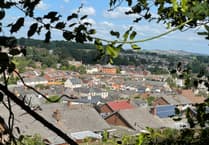COUNCILLORS are set to be asked to back plans that could see Exeter’s infamous General Buller statue relocated.
The statue of Crediton-born General Sir Redvers Buller and his horse Biffen stands on the corner of New North Road and Hele Road outside the entrance to Exeter College and was erected back in 1905.
But last year, calls had been made to review the appropriateness of the monument, not only because of the man it portrays, but because of the names carved on the plinth of colonial campaigns which sought to advance British imperialist interests in other countries.
The July 2020 meeting of Exeter City Council’s Executive resolved to investigate the continued appropriateness of the statue of General Buller and his horse Biffen in its current location, and to act accordingly on its findings, and next Tuesday, January 12, the councillors are asked to act on the findings.
The report to the meeting asks them to note the findings of the Scrutiny Task and Finish Group and that the Portfolio Holder for Culture and Communities establish a working group to develop an Anti-Racism Strategy for the Council, and also for a new public art strategy for the city to be created.
And the executive is asked to that, without prejudice to a final decision on the matter, an application be made for listing building consent for the relocation of the statue to an alternative location.
This will provide an opportunity for public consultation on the proposed, prior to a final determination of the matter by Council, and that in the meantime, temporary information boards be erected near to the statue.
Director Jon-Paul Hedge, in his report, says: “The statue of General Buller was erected in 1905 during his lifetime, and paid for by public subscription. He was something of a controversial figure at the time but was apparently popular with many in Exeter.
PUBLIC DEBATE
“The statue has today become a cause of some public debate not only because of the man it portrays, but because of the names carved on the plinth of colonial campaigns which sought to advance British imperialist interests in other countries.
“This decision was made within the context of the Black Lives Matter movement against systemic racism and followed campaigns within a number of towns and cities across the UK to reconsider the present appropriateness of statues, especially those of prominent people involved in the transatlantic slave trade or advancing British imperialism and colonialism.”
The Scrutiny Task and Finish Group met on four occasions and took written and oral submissions from a range of stakeholders, including local historians and history groups, local Black, Asian and Minority Ethnic Community Groups and a historian who has worked with Bristol City Council on their review into the siting of the statue of Edward Colston.
Following a discussion on the findings, the group members submitted their own position statements on the matter, which were also discussed, with three members voting to relocate the statue and two voting for it to remain in place.
INAPPROPRIATE
The report says that discussions among the group included that the current location is inappropriate because it is outside an educational establishment which includes young people from diverse backgrounds, but that the statue’s future location should not be somewhere hidden from the public but be in a place, and linked to an organisation, that is in a better position to work with the public on the interpretation of the statue.
They also discussed that the advancement of the British Empire was founded on the premise that other nations and peoples were inferior, and British colonisation and rule would only be of benefit to them, and this statue and others like it cause pain to people from Black, Asian and minority ethnic backgrounds as they serve as a constant reminder of the trauma that colonised countries experienced which gets passed down generations.
Consideration should be given to whether the statement “He saved Natal” on the plinth should be removed, was also a conclusion they made.
Mr Hedge’s report adds: “The Task and Finish Group decision is not based only on an assessment of General Buller himself or of the time in which he lived. The decision is also based on assessment of the role that public statues should have in reflecting present-day values of inclusivity in the city, and the appropriateness of its current location.
“The Task and Finish Group feel that the debate around this statue is an opportunity to conduct a wider conversation with the residents of Exeter on the role of public art in the city, and a working group including the University of Exeter and Exeter Culture, will be set up to begin this work with the aim to develop a public art strategy for the city.
“An Anti-Racism Strategy is a proactive document. It sets out the actions an organisation will take to tackle systemic racism within the way it operates. These actions might include scrutinising policies and procedures for implicit bias, training staff on systemic racism and unconscious bias and involving BAME residents in decision making.”
£25,000+ COST
The cost of the relocation of the statue has been estimated at a minimum of £25,000, while to erect two temporary information boards, it will cost £256.80 which the Portfolio Holder has identified from existing budgets.
If agreed by the executive when they meet next Tuesday, an application would be made for listing building consent for the relocation of the statue to an alternative location, although this would not commit the council to carrying out the act.
The statue and plinth are Grade II listed and as such any relocation or changes made to it would be subject to formal Listed Building Consent under the 1990 Act, and Exeter City Council would need to seek the consent from another authority and cannot give consent to itself.
CONSULTATION
A full public consultation would then take place over the future of the Buller statue before a final decision would be made by the full council at a later date.
The statue was paid for by money raised by the people of Devon and unveiled on “Buller Day” in 1905.
It is currently situated on land owned by Devon County Council, with the monument itself maintained by the city council.
Buller served in Canada, China and most famously in South Africa in the Zulu Wars. It was here an operation led by him went wrong and he had to withdraw under intense fire.
Some have alleged that he was partly responsible for the creation of British “concentration camps” where thousands of people died, a claim denied by descendant Henry Parker, who said: “This is completely false, he had left South Africa before they started, he was not party to the policy, he would have strongly opposed it.”
FALSEHOODS
Mr Parker also said there were “many falsehoods circulated about him in recent months”.
He added: “I am dismayed that his statue in Exeter might be removed.”
The statue of Buller on his horse has previously been vandalised, with in 2019 an anarchist symbol and the word “scum” have been daubed on the statue, while banners saying “wanted for war crimes” had also been hung on it.
General Sir Redvers Buller is regarded as Crediton’s second most celebrated son of modern times.
His distinguished military career included campaigns in the Sudan and the Boer War.
He was held in very high regard by his troops who nicknamed him the “People’s General”.
MEMORIAL
He was also held in high regard by the people of the Crediton and Exeter. He is remembered by the memorial in Crediton Parish Church and by the statue of himself on horseback in Exeter.
General Buller was General Officer Commander at the British Army headquarters at Aldershot from October 1898 to October 1899 and January to October 1901.
In addition to his Crediton home at Downes (where he was born in 1839), he also lived in an Army-supplied home at Aldershot while serving there.
He was the recipient of the Victoria Cross in 1879 following the Zulu Wars. He received the VC for his bravery after saving four of his men despite heavy losses.
VICTORIA CROSS
The Victoria Cross is the highest military decoration for gallantry and valour in the face of the enemy awarded to British and Commonwealth servicemen.
Following the Boar war, he returned to Crediton amid great revelry.
He was given the Freedom of Exeter by Exeter City Council and the County of Devon gave him a bejewelled sword, which hangs in Exeter Guildhall.
He died at Downes House, as Lord of the Manor on June 2, 1908, aged 69.
He is buried in the Buller Family Memorial in the north east corner of the churchyard at Crediton Parish Church.
General Buller was the second son of James Wentworth Buller, MP for Exeter.
The public is invited to have a say on the future of the statue at: [email protected] .
• Why not share your comments with fellow Courier readers? Email: [email protected] .
Alternatively, write to: The Editorial Manager, Crediton Courier, 102 High Street, Crediton EX17 3LF.
By Daniel Clark and Alan Quick



